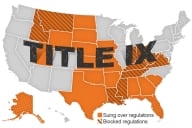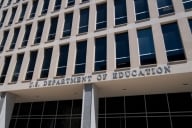You have /5 articles left.
Sign up for a free account or log in.
House Republicans and President Trump have signaled an interest in evaluating whether congressional earmarks could be restored for the first year since 2011. That discussion has rekindled a long-running debate in higher ed about the appropriations tool and whether colleges should pursue earmarks at all.
That’s been a moot point since 2011, when Congress, led by conservative Republicans, banned earmarks. The spending provisions are essentially any language included in legislation by an individual lawmaker directing spending to a particular project. And they make up just a tiny fraction of overall federal discretionary spending. But many earmarks were substantial -- well over $10 million in many cases -- and the projects were never reviewed on their scientific or educational merits.
Further, earmarks got a bad name due to some notorious and high-profile spending projects with little apparent benefit to the public.
Higher ed may be less well-known for examples of individual “pork-barrel” projects that attracted public backlash. But colleges and universities were big recipients of earmarks. An Inside Higher Ed analysis found that in the 2010 fiscal year, higher ed institutions received close to $2 billion in grants from individual members of Congress.
Most of that money went toward academic research, including the construction of new research facilities, but higher education leaders have been split about whether earmarks are an appropriate way to fund that activity. Some colleges lobbied actively -- and effectively -- for the earmarks when they were still allowed.
“Both Democratic-leaning states and Republican-leaning states received earmarks. Both Republican and Democratic members of Congress sought earmarks,” said Chris Marsicano, a doctoral student in leadership and policy studies at Vanderbilt University who focuses on lobbying by universities.
Conservative leaders and members of the Tea Party may have led the charge in ending the practice, he said, but they also didn’t turn the money away for their own districts.
Some elite research institutions have frowned upon the use of earmarks, though, or at least the active pursuit of those grant funds. The Association of American Universities, which represents more than 60 top research universities, at one point publicly backed a ban on earmarks.
Since 2005, its position has been that exceptions to merit-based funding shouldn’t be used by member institutions as license to pursue earmarks. AAU’s gripe has been that earmarks threaten merit-based federal support of scientific research -- the competitive funding that its members excel at winning.
Other lower-tier research institutions have argued that the funds give them a shot at competing with elite institutions with serious advantages in applying for federal grants. And other supporters in higher ed say lawmakers who know the needs of their states and districts are better positioned than the staffs of federal agencies to make certain funding decisions.
Some of the biggest beneficiaries of earmarks among higher ed institutions have of course been colleges and universities represented by influential lawmakers on key committees. Campuses in states like Alabama, Hawaii, Mississippi and West Virginia ranked among the top recipients of academic earmarks before the 2011 ban. Lawmakers often directed funds to colleges and universities back home even when they were unsought or when campuses weren’t already doing the kind of research supported by the grant.
Despite AAU’s stance as a group against earmarking, some members have supported their return. The University of Kansas, an AAU member, has welcomed discussions of restoring earmarks. Jack Cline, the director of federal relations at the university, said students and citizens expect public universities to keep up with developments in technology and infrastructure that many private universities have had in place for years.
“This requires significant economic investment that, unfortunately, often isn’t supported by state legislatures,” he said.
Cline said appropriations and spending are part of the responsibilities of members of Congress. And he added that lawmakers are uniquely qualified to work with state and local officials to decide where economic investments are made.
House Committee on the Rules Chairman Pete Sessions, a Texas Republican, plans to hold a hearing next week on the earmark issue.
Among the backers of restoring earmarks is Representative John Culberson, a Texas Republican. Culberson called the spending requests “good public policy” and said they would allow Congress to more quickly direct federal agencies to respond to events like Hurricane Harvey, which led to flooding in much of his district.
“I’m proposing that we restore the ability of members of Congress to direct money toward flood control or highway projects when we receive a request from a local or state unit of government,” he said in a statement. “We would submit the request at the subcommittee level, and the request would then go through the entire legislative process, out in the open, so that the public can see it and debate it. Most importantly, these projects would not increase spending.”
The suggestion has already received an endorsement from President Trump, whose statement in support of earmarks as a way to break legislative stalemates has drawn rebukes from conservative commentators. Citizens Against Government Waste, a nonprofit which has long opposed earmarking, released a statement this week blasting the president's endorsement.
“Earmarks are a lazy, unfair and corrupt way to circumvent the authorization and appropriations process,” the group said. “They have been roundly excoriated by the conservative movement upon which Republicans depend for their political lives.”
A 2007 paper reported that a number of studies had found research supported by earmarks was of a lower quality and did little to advance the academic ranking of institutions that received those funds. Brian Silverman, a co-author of the paper and an associate dean at the University of Toronto Rotman School of Management, said he didn't see how the earmarking process could be improved to better support high-quality research.
"It is unreasonable to expect either congressional representatives or their staff to be sufficiently knowledgeable about the frontiers of academic research that they can make informed decisions about projects," he said in an email.
But institutions that support their return say earmarks have supported infrastructure on campus that allows them to better compete for peer-reviewed grants awarded by federal agencies.
One measure that’s been unaffected by the ban is overall spending on lobbying by higher ed. In fact, Marsicano said, colleges have actually increased the amount they spend on in-house lobbying while spending the same amount as before on lobbying by outside firms.
“The earmark ban didn’t stop the lobbying spending,” he said. “It did the exact opposite.”
One reason, he said, was that many institutions have had to hire specialists who focus more on the executive branch.
Glynda Becker, director of federal relations at Washington State University, said after the 2011 ban the university’s faculty and staff members became more strategic in making requests for federal appropriations. That will continue if Congress does vote to restore earmarking, she said.
“The onus is on the institution to be able to defend their research,” she said. “If we are going to go in and ask for earmarks, we’re going to be able to defend what we’re doing.”








